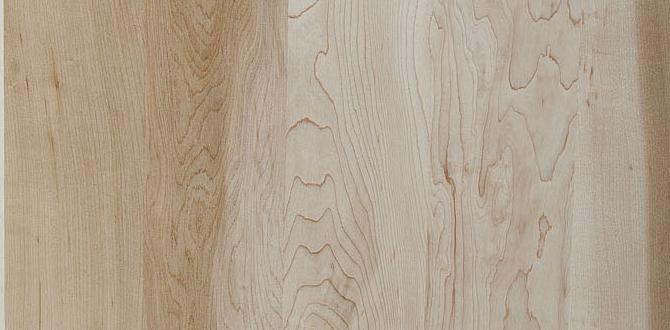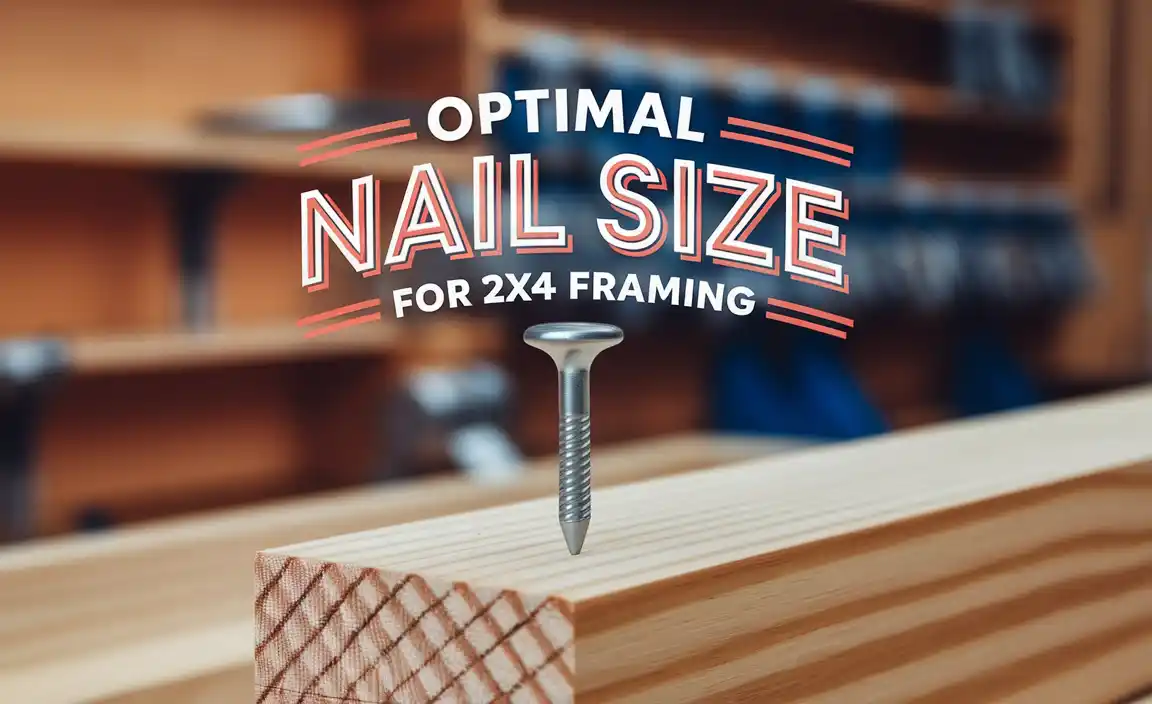Quick Summary:
Bent nails in your nailer’s magazine? Don’t worry! This guide offers simple, step-by-step solutions for common causes. Learn how to quickly identify, fix, and prevent bent nails so you can finish your projects efficiently and safely.
Hey there, fellow DIYers and woodworkers! Jack Shaffer here, your go-to guy for all things nail guns. If you’ve ever been mid-project, ready to fire off a perfect nail, only to hear a frustrated thwack and see a bent nail sticking out, you know the feeling. It stops your workflow dead in its tracks and can be super annoying. But here’s the good news: troubleshooting bent nails in the magazine is usually a straightforward fix. We’ll walk through the most common reasons this happens and how to get your nailer back in action in no time. Ready to banish those bent nails forever?
Table of Contents
Why Do Nails Get Bent in the Magazine? Understanding the Culprits
It’s a common headache for both beginners and seasoned pros: nails getting jammed or bent inside the nailer’s magazine. This isn’t just an inconvenience; it can damage your tool if not addressed properly. Understanding why this happens is the first step to fixing it. Think of it like a traffic jam for your nails. Sometimes, there’s a simple roadblock, and other times, a more significant issue is at play. Let’s break down the most frequent culprits.
1. Incorrect Nail Size or Type
This is probably the most common reason for bent nails. Nail guns are designed to work with specific sizes and types of nails. Using nails that are too long, too short, too thick, or too thin for your particular nailer is a recipe for disaster. They simply won’t feed correctly.
- Too Long: If a nail is too long, it can jam against the nose of the gun or get misaligned as it tries to exit the magazine.
- Too Thick: A nail that’s too wide might not slide smoothly down the magazine channel, causing it to bind and bend.
- Too Short: Shorter nails can sometimes tumble or get out of alignment, leading to misfires and potential jams.
- Wrong Shank Type: Different nailers are designed for specific nail shank types (e.g., smooth, ring, screw). Using the wrong type can cause feeding issues. For example, a framing nailer won’t typically cycle smooth shank finish nails properly.
Always check your nailer’s manual to confirm the exact specifications for the nails it’s designed to use. Reputable manufacturers, like DEWALT, provide detailed specifications for their tools, ensuring you use compatible consumables.
2. Poor Quality or Damaged Nails
Not all nails are created equal. Cheaper, lower-quality nails can have manufacturing defects that lead to bending. These might include:
- Slight variations in diameter or length.
- Irregular heads that don’t sit properly in the magazine strip.
- Weakened shanks that bend easily.
Even good quality nails can be damaged during shipping or handling. If you notice that a particular strip of nails is causing problems, it’s often best to discard them and use a fresh, known-good strip.
3. Misaligned Strips
Nails are typically held together in strips with glue, paper, or plastic collation. If these strips aren’t perfectly straight or if the nails are not inserted at the correct angle within the strip, they can snag in the magazine. Sometimes, the collation material itself can break or jam.
When loading nails, take a quick second to ensure the strip is straight and the nails are seated correctly in their channels. If you suspect a strip is faulty, try using another one before blaming the tool.
4. Worn or Damaged Magazine Components
The magazine is the part of the nailer that holds the nails and guides them to the firing mechanism. Over time, or due to accidental impact, parts of the magazine can become worn, bent, or chipped. This can create friction points or misalignments that cause nails to jam.
- Magazine Ramps: The internal ramp guides the nails. If it’s bent or damaged, nails won’t feed smoothly.
- Feeder Piston: This component pushes the nails forward. If it’s damaged or not moving freely, it can cause jams.
- Ejection Port: Sometimes, a bent nail can get stuck on the edge of the ejection port as it tries to exit.
If you notice visible damage to the magazine, it might be time for a repair or replacement. Many nailer magazines are designed to be user-replaceable, while others might require professional service.
5. Debris or Obstructions
Small pieces of wood, dust, or even broken collation material can accumulate inside the nailer’s magazine or feeding mechanism. This debris can act like tiny speed bumps, causing nails to snag or become misfed, leading to bends.
Regular cleaning is key to preventing this issue. A quick blast of compressed air or a gentle wipe with a clean cloth can often clear minor obstructions.
6. Improper Loading Technique
How you load the nails into the magazine can also play a role. If you force a strip in, or if it’s not seated properly, it can misalign the nail strip right from the start.
Ensure the magazine is empty before loading. Slide the strip in firmly and ensure any spring-loaded retainers snap into place correctly. Some nailers have specific loading procedures, so consult your manual if you’re unsure.
Troubleshooting Bent Nails: A Step-by-Step Guide
Okay, so you’ve encountered a bent nail. Don’t panic! Here’s a practical, step-by-step approach to diagnose and fix the problem without damaging your tool further.
Step 1: Safety First – Disconnect Power!
This is the absolute most crucial step. Before you do anything else, disconnect the power source to your nailer. This means:
- For Pneumatic Nailers: Disconnect the air hose from the compressor or the nailer itself.
- For Cordless (Battery) Nailers: Remove the battery pack.
- For Electric/Corded Nailers: Unplug the unit from the power outlet.
Never attempt to clear a jam or inspect the magazine while the tool is connected to a power source. This prevents accidental firing and serious injury.
Step 2: Remove the Remaining Nails
Carefully unload any remaining nails from the magazine. If the bent nail is preventing you from opening the magazine fully, you may need to gently work it loose. Sometimes, sliding the magazine open (if it’s a non-marring type) or carefully maneuvering the nail can free it.
Step 3: Inspect the Bent Nail and Magazine
Now, take a close look at the bent nail. Is it severely mangled, or just slightly kinked? Also, examine the magazine channel where the nail was located.
Visual Inspection Checklist:
- The Nail: Look for manufacturing defects, damage, or if it’s the wrong size/type for your tool.
- The Magazine Channel: Check for any visible damage, dents, or foreign objects. Pay attention to the feed ramp and the nose of the magazine.
- Collation Material: Is there any torn paper, plastic, or glue residue stuck in the magazine?
Table 1: Common Nailer Magazine Issues and What to Look For
| Issue | What to Look For | Likely Cause |
|---|---|---|
| Bent Nail Jam | Nail is visibly kinked or deformed within the magazine channel or at the nose. | Incorrect nail size, damaged nail strip, debris, worn magazine track. |
| Misfed Nail | Nail is not straight or angled correctly in the magazine, preventing proper feeding. | Poorly collated strip, debris, damaged feed ramp. |
| Collation Jam | Torn paper, plastic, or excessive glue is obstructing the nail feed. | Poor quality collation material, aggressive improper loading. |
| Magazine Damage | Dents, cracks, or bent metal on the exterior or interior of the magazine. | Dropping the tool, impact, wear and tear. |
Step 4: Gently Remove the Bent Nail
Most of the time, you can remove a bent nail by simply pulling it straight out. If it’s stuck, try wiggling it gently. Tools like needle-nose pliers or a small flathead screwdriver can be helpful, but be extremely careful not to scratch or further damage the magazine interior.
Pro Tip: If the nail is really jammed, try slightly pushing the nail strip forward from the back of the magazine (if your model allows) while gently pulling the bent nail forward. Sometimes, this relieves the tension.
For pneumatic nailers, a quick burst of air (with the battery/air disconnected) directed into the breach might help dislodge a stubborn nail, but use this technique cautiously. Refer to your tool’s manual for specific recommendations.
Step 5: Clear Any Debris
Once the bent nail is out, thoroughly inspect the magazine for any fragments or debris. Use compressed air to blow out any dust or small particles. A soft brush or a lint-free cloth can help remove stubborn residue.
A clean magazine is crucial for smooth nail feeding. Think of it like clearing a clogged pipe – you need it open and clear for things to flow properly.
Step 6: Test with New, Correct Nails
Load a new strip of the correct size and type of nails into the magazine. Ensure they are seated properly and the strip is straight.
Reconnect the power source (air, battery, or plug).
Perform a test fire into scrap material. Listen for the normal firing sound and observe if the nail drives correctly. Try firing a few more nails to ensure the issue is resolved.
Preventing Bent Nails: Best Practices for Your Nailer
Fixing a bent nail is one thing, but preventing them from happening in the first place is the real goal. By adopting a few good habits, you can significantly reduce the occurrence of this frustrating problem.
1. Always Use Manufacturer-Specified Nails
This cannot be stressed enough. Your nailer was engineered to work with specific nail dimensions and types. Using anything else is asking for trouble.
- Check your tool’s manual for the exact specifications regarding nail length, diameter, and collation angle.
- Don’t guess! Buy nails specifically listed as compatible with your nailer model.
- Brands like Paslode offer a wide range of compatible fasteners for their tools.
2. Invest in Quality Nails
While it might be tempting to save money with generic or discount nails, the potential for jams and bent fasteners often outweighs the savings. High-quality nails are made with tighter tolerances, ensuring they feed and fire consistently. This can save you time, frustration, and potential tool damage in the long run.
3. Inspect Nails Before Loading
Before you slide that strip of nails into your gun, give it a quick visual check. Look for:
- Damaged or bent nails within the strip.
- Cracked or broken collation (paper, plastic, or glue).
- Nails that aren’t seated straight in the strip.
If a strip looks questionable, don’t risk it. Set it aside and use a new one.
4. Load Nails Carefully and Correctly
Take your time when loading the magazine. Ensure:
- The magazine is completely empty.
- The nail strip is oriented correctly (check your manual for the proper angle).
- The strip is pushed in fully until it locks into place.
- Avoid forcing the strip. If it doesn’t slide in smoothly, there might be an obstruction or the strip isn’t aligned properly.
5. Keep Your Nailer Clean and Well-Maintained
Regular maintenance is key to tool longevity and performance. After each use, and especially if you’ve been working in dusty conditions:
- Disconnect power.
- Use compressed air to blow out any dust or debris from the magazine and around the nosepiece.
- Wipe down the exterior of the tool.
- Periodically check the magazine for any signs of wear or damage.
- Lubricate your pneumatic nailer according to the manufacturer’s recommendations.
This is especially important for pneumatic tools, as moisture and debris buildup can corrode internal parts. For more in-depth maintenance tips, resources like Popular Mechanics often provide excellent overviews of tool care.
6. Avoid Firing “Dry” Repeatedly
While occasional dry firing (firing the nailer without nails in the magazine) won’t necessarily cause a bent nail, repeated dry firing can put undue stress on the internal firing mechanisms. It’s best practice to avoid it whenever possible.
7. Store Your Nailer Properly
When not in use, store your nailer in a clean, dry place. Protect the magazine and nosepiece from impacts that could cause damage during storage or transport.
Common Nailer Magazine Troubleshooting Scenarios
Let’s look at a few typical situations and how our troubleshooting steps apply:
Scenario 1: Nails Keep Jamming at the Very Tip of the Magazine
Possible Causes:
- Nails are too long or slightly bent before entering the magazine.
- The magazine tip or feed ramp is slightly damaged or bent inwards.
- Debris is caught right at the exit point.
Solution: Disconnect power, remove nails, inspect the tip and feed ramp for damage or debris. Use compressed air to clear. If the ramp is visibly bent, it might need professional repair. Try with a different strip of nails.
Scenario 2: Nail Strips Don’t Feed Smoothly, Even with New Nails
Possible Causes:
- Nails are the wrong collation angle (e.g., 15° nails in a 21° gun, or vice-versa).
- The feeder piston isn’t moving freely, or the magazine spring is weak.
- Internal debris is causing friction throughout the magazine channel.
Solution: Verify the collation angle matches your nailer. Disconnect power, remove all nails, and carefully inspect the entire magazine channel for debris. Try a different brand/batch of nails. If the feeder piston seems stuck, a light lubricant (check manual first!) might help, or it could indicate internal wear.
Scenario 3: A Folded or Severely Damaged Nail is Stuck Fast
Possible Causes:
- A previous misfire or jam was not fully cleared.
- A very low-quality nail snapped and pieces jammed.
- The tool experienced a significant impact.
Solution: Disconnect power. This requires patience. Carefully use needle-nose pliers or a sturdy pick tool to try and grip and dislodge the nail. Work in short, precise movements to avoid further damage. If it’s truly stuck, consult your tool’s manual or a service center. Don’t force anything excessively, as you could crack the magazine housing.
When to Seek Professional Help
While most bent nail issues can be resolved with the steps above, there are times when it’s best to let the experts handle it. If you encounter any of the following, consider taking your nailer to an authorized service center:
- The magazine is visibly cracked or severely bent, and you can’t safely attempt a repair.
- A nail is jammed so tightly that you risk damaging the tool trying to remove it.
- You suspect internal damage to the feeding mechanism (feeder piston, drive track).
- The problem persists even after trying all the troubleshooting steps with new, correct nails.
- Your tool is still under warranty, and attempting a fix might void it.
Remember, even the best tools can have manufacturing defects or suffer damage. Knowing when to call for backup is part of being a smart tool user.
Frequently Asked Questions (FAQ)
Q1: Can I use glue nails in a paper-collated nailer?
A1: Generally, no. Nailers are designed for a specific collation type


